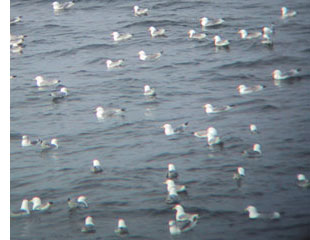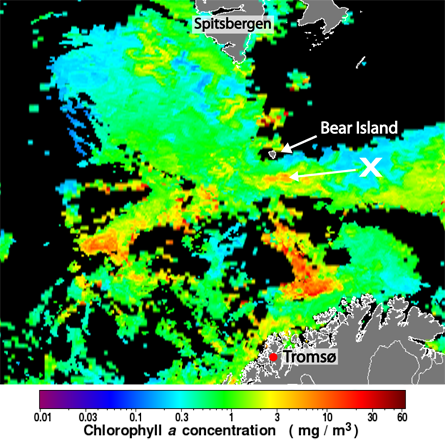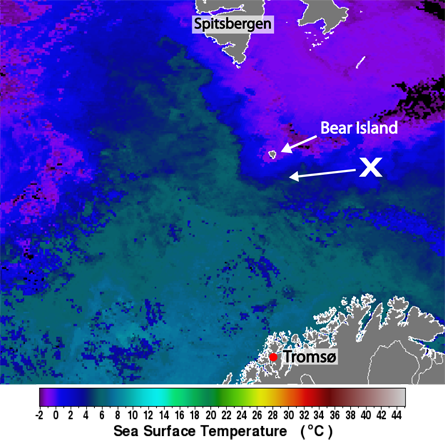Inleiding
Oceaanstromen hebben een belangrijke invloed op het leven in de oceaan. Samen met de beschikbaarheid van zonlicht, het verloop van
de seizoenen en het opwarmen en afkoelen van oppervlaktewateren regelen zij de fysieke omstandigheden waaronder a
lle mariene leven bestaat.
Net zoals op het land staan planten onderaan de voedselketen, dus de beschikbaarheid van voedsel
voor zeedieren hangt uiteindelijk af van de productiviteit van zeeplanten.
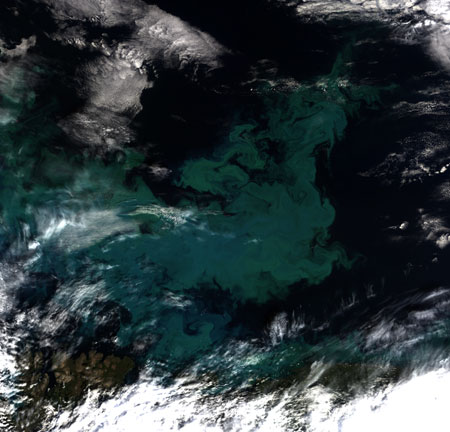
Envisat MERIS true colour image of a phytoplankton bloom in the Barents Sea, 12th August 2008. During the Arctic summer,
melting of sea ice helps to stabilise the water column, so phytoplankton are able to remain in the sunlit surface zone.
The long nights, and nutrients brought up from the deep where currents flow over sea-mounts or ridges, can give rise to
bright blooms such as this.
Phytoplankton bloom in the Barents Sea
Plant life depends on light and nutrients
In tegenstelling tot op het land is het leven in de zee in grote mate een 3-D-aangelegenheid
en het overgrote deel van de oceaan is koud, diep en donker.
Plants can only
Fotosynthesise in the sunlit zone near the surface. Plant growth on the sea floor is only possible in shallow water near land. The
majority of plants in the ocean are tiny, single-celled plants that drift with the currents near the surface - the phytoplankton.
If turbulence brings the phytoplankton down into the dark zone, they die. But near the surface essential plant nutrients are
soon used up. Unless new nutrient rich water flows up from the deep, growth will be slow. Thus concentrations of phytoplankton
cells are low in areas with little vertical movement of water.
Why is the ocean teeming with life?

Why was the sea suddenly teeming with life?
On the way from Tromsø in Norway to Spitsbergen via Bear Island the Cape Farewell ship the Noorderlicht suddenly found itself
in an area with thousands of gulls, storm petrels and other birds, as well as fish, seals, dolphins, hump-back whales, and
possibly even orcas.
Water samples contained large numbers of zooplankton (tiny marine animals). Later satellite images of ocean colour revealed
a small phytoplankton bloom in the area (image below, left). Phytoplakton are microscopic plants, and a Bron of food for
zooplankton, which in their turn are food for fish, birds an so on, up the food chain. Blooms often occur near ocean
fronts - regions where water from different currents with different temperatures meet and mix.
Look at the satellite images below. How does the bloom and all the feeding activity observed by the Cape Farewell
expedition relate to the Polar Front (the region where cold, Arctic water meets the warmer Atlantic water)?
Fotos:
Thousands of gulls (top left), a predator with prey glimpsed through the water (bottom left) and humpback whales (below).
Bron: Cape Farewell
Satellite images:
Chlorophyll concentration (left) and sea surface temperature (right) for the region between Tromso and Sptisbergen 25 May - 1
June 2003. The cross with arrow points to the location for the sea-life Fotos.
Click on the images for a wider view in a new window.
Bron: NOCS. Data from
NASA/MODIS-Aqua and
USGS Coastline Extractor.
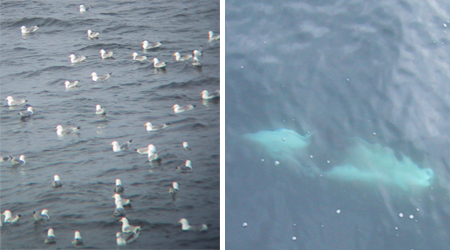
Sailing from Tromsø in Norway to Spitsbergen the Cape Farewell team suddenly found their ship surrounded by thousands of birds.
Looking around they saw seals, dolphins and humpback whales. After over two days of seemingly empty seas, what was the reason
for all this activity?
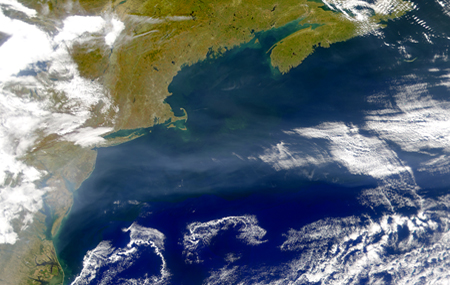
SeaWiFS. The Gulf Stream waters are warm and oligotrophic, low in nutrients. They are deep blue
while the cooler, more-nutrient-rich waters to the north are milky blue due to the phytoplankton. (click on image for a larger
version)
Bron: NASA Visible Earth.
This chapter looks at how ocean currents affect the availability of plant nutrients, the global patterns of phytoplankton productivity,
and the productivity of marine ecosystems around the world.

